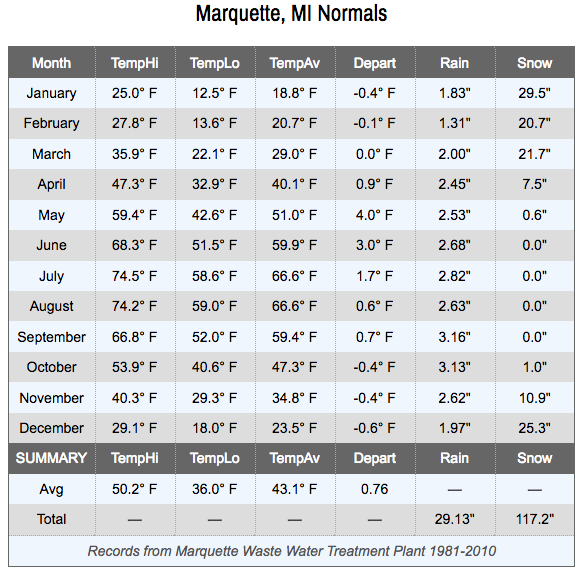Sometimes, when you hear or read “a new record was set in Marquette today” in media reports, they are referring to the National Weather Service office in Negaunee Township. Such was the case yesterday, when it was widely reported that a daily snow record of 8.9″ was set on November 19th. Marquetters may have been scratching their heads thinking, “We maybe got 5 or 6″. I don’t see how we got 9!”
You may already be aware that the phrase “NWS Marquette” does not refer to the city proper. Sometimes, however, that phrase is omitted or put in small letters at the bottom of a graphic when discussing “Marquette’s” weather. It’s especially confusing for people who aren’t from here (students, for example) or visiting.
There’s about an 8 mile and 800ft elevation difference between the weather service forecast office just outside Negaunee and the lakeshore of Marquette. As a result, the former averages approximately 200″ of snow annually. The city of Marquette, as measured at the COOP station on Lakeshore Blvd, receives a yearly average of just under 120″. So about 40% less snow falls there than at the NWS office.
In Real Terms
To illustrate, on Nov 19-20 when the NWS office measured 12.3″, the Marquette COOP reported 6.7″ (and that’s including part of the 18th and 21st too). We’re 1 mile SW of the COOP station as the crow flies, and we recorded 6.1″ of snow for the 19th and 20th.*
So, no, we’re not under measuring. It may seem like Marquette received more than half a foot during that period, but drifts are excluded from our measurements. Boy are they impressive in places though! The gales will do that.
That said, we’ve still had one incredible November for snowfall! Officially, 14.2″ of snow had fallen by 8AM today. The normal total for the entire month is 10.9″. Unofficially, at our station next to the Vet’s Home, the 8AM total was 17.3″ with 9 days to go! We tend to measure a bit more snow at our location than they do down at the lakefront. That’s because:
- We are about 100′ higher which usually means more snow.
- We measure more often which prevents snow from sublimating (evaporating), melting or compacting.
Well, if you’re in Marquette, I hope you like a white holiday. Happy Thanksgiving to you and yours!
————————-
UPDATE (later that day): Here’s an example headline: Marquette in Michigan’s Upper Peninsula sets daily snowfall record. While this is from downstate, I’ve seen similar things from the local media here.
UPDATE (11/22/18): Speak of the devil, here’s a link to local media spreading confusion: Monday’s snowfall breaks record for Marquette. Earth to media: we have a 147 years of public weather records in Marquette, and, oddly, they weren’t measured in Negaunee Township.
————————-
* The NWS and this station record weather from midnight to midnight. The COOP station records from 8AM – 8AM making daily comparisons a bit difficult.

